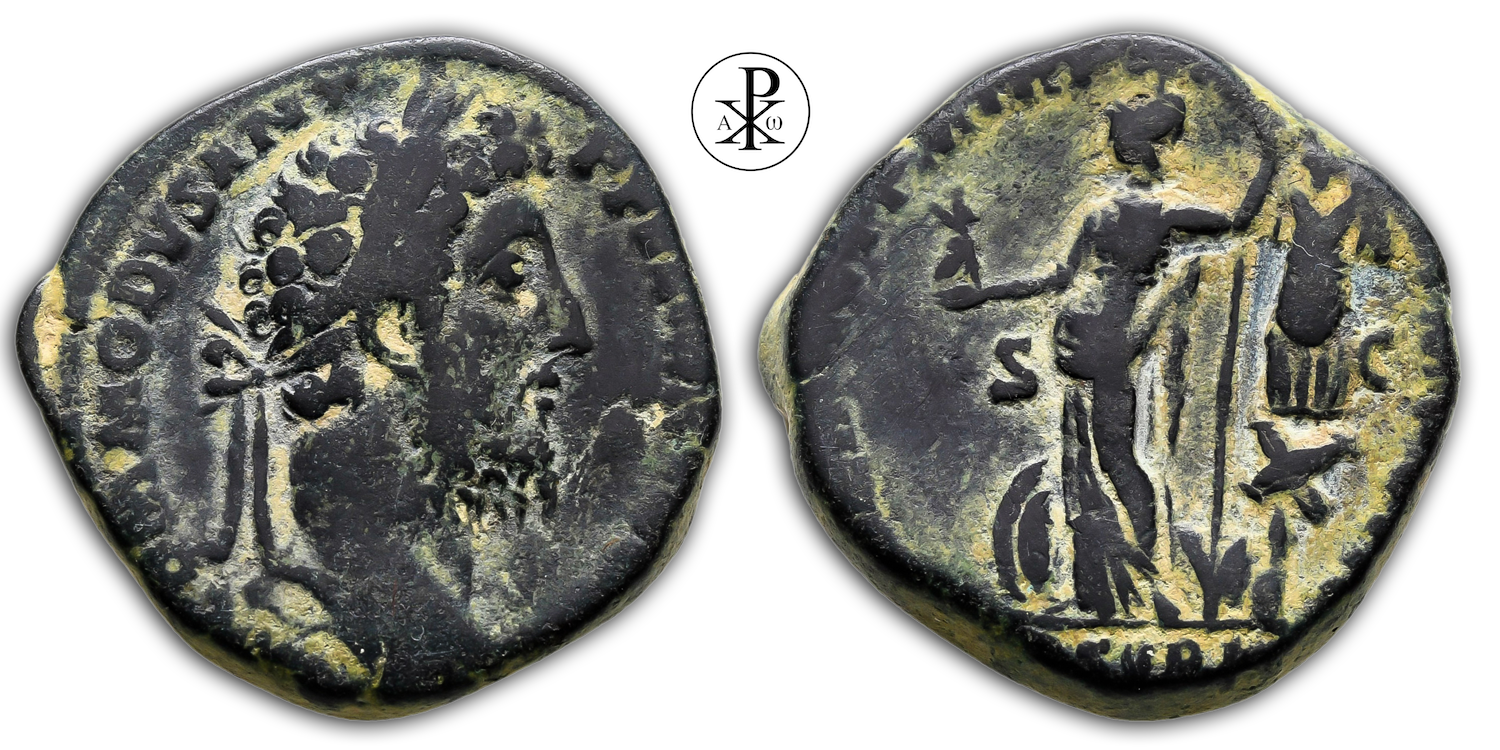Imperator Caesar Marcus Aurelius Commodus Antoninus Augustus
Reign: Commodus
Mint: Rome
Date: 188/189 AD
Nominal: Sestertius
Material: AE Bronze
Diameter: 30mm
Weight: 24.90g
Reference: RIC III Commodus 528
OCRE Online: https://numismatics.org/ocre/id/ric.3.com.528
Rare: R1
Provenance: Savoca Numismatik Munich, Germany (Auction 157, Lot 990)
Pedigree: From the Tareq Hani Collection
Obverse: Head of Commodus, laureate, right
Inscription: M COMMODVS ANT P FELIX AVG BRIT
Translation: Marcus Commodus Antoninus Pius Felix Augustus Britannicus
Translation: Marcus Commodus Antoninus, the pious, the fortunate, Augustus, conqueror of the Britons
Reverse: Minerva, helmeted, draped, standing left, holding Victory in extended right hand and spear in left hand; to left, shield; to right, trophy
Inscription: MINER VICT P M TR P XIIII IMP VIII COS V P P S C
Translation: Minerva Victrix. Pontifex Maximus, Tribunicia Potestate Quarta Decima, Imperator, Octavum, Consul Quintum, Pater Patriae. Senatus Consultum
Translation: Minerva, the victorious. High priest, holder of tribunician power for the 14th time, Imperator for the eighth time, consul for the fifth time, father of the nation. Decree of the senate
Comment: Minerva is a Roman goddess who was worshipped especially by the Sabines, Etruscans and Latins. The Etruscans called her Menrva. The Greek goddess Athena corresponds to her. In the Roman Empire, Minerva was initially regarded primarily as the protector of craftsmen and trades. Later, elements of the Greek cult of Athena were adopted into the image of Minerva, thus she also became the patron goddess of poets and teachers. Minerva was the goddess of wisdom, tactical warfare, art and shipbuilding, and guardian of knowledge. Since Augustus, she has been worshipped as the goddess bestowing victory or directing the fortunes of the state. A particular devotee of Minerva was the emperor Domitian, who often had her depicted on the reverse of his coins. In Rome, Minerva was worshipped as one of the three city deities on the Capitol, along with Jupiter and Juno. Her temple once stood in the center of the Aventine Hill. Today, however, no remains of it have survived. A second temple was located – also since Republican times – on the Esquiline. This was dedicated to Minerva Medica, who was the patron goddess of physicians. A third temple was located on the Caelius. This was named “Temple of Minerva Capta” because the cult image had been stolen by the Romans from the conquered Falerii in 241 BC.
Victorious Minerva of Commodus – African unrest or third campaign to Germania? Historically not secured are the “warlike” coinages of Commodus in the years 188 and 189 AD. Coins are minted with the themes Fortuna Redux, Victoria Felix, Mars Pacator etc. – even in Alexandria a coin with the sacrificing emperor, crowned by Nike, is issued. Likewise, a profectio medallion appears in this period – the only question is, where should the journey go? Sources report Commodus intention to undertake a third Germanic campaign, but he was prevented from doing so by the Senate and the people (Comm. 12, 8; cf. CIL V 2155 = Dessau 1574). Apparently unrest took place in Upper Germania (cf. the inscription of Urbinum Wilmanns 1459 = Orelli 3714; also Comm. 13, 5: in Germania). Also Africa could be considered – allegedly Commodus intended a journey there (Comm. 9, 1). The Historia Augusta reports about unrest in Africa under the proconsulate of Pertinax in the years 188 and 189 AD. Only this is still no proof that Commodus wanted to lead a campaign in Africa. Where the, perhaps warlike, journey should lead, remains so far unclear. Only one thing is certain, no matter where, Commodus did not start it. Whatever (warlike) threat it may have been in the end, however, in the year 189 AD the emperor finally let himself be celebrated as the peacemaker of the (Roman) world with “Securitas Orbis” coins.
